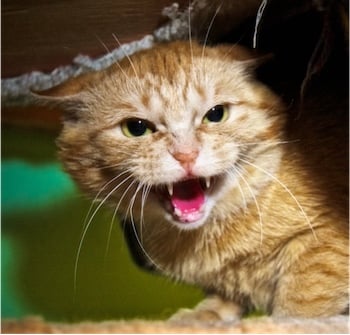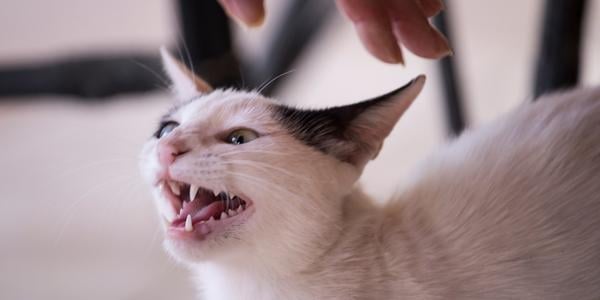 Signs of feline aggression, at least ones that we humans are able to decipher, are expressed through a cat’s body language, which includes body postures, facial expressions, and vocalization.
Signs of feline aggression, at least ones that we humans are able to decipher, are expressed through a cat’s body language, which includes body postures, facial expressions, and vocalization.
Cat vocalization is the easiest for us to interpret. Most of us recognize a growl, snarl, or hiss as a warning sign to stay away.
A cat's physical movements and postures are more complex because it involves translating the meaning of multiple body parts moving at the same time.
To complicate matters, cats use almost every part of their body to display their emotion — from the position of their ears, the direction of their body, and the movement of their paws to various body postures.
Unraveling this maze of body postures, facial expressions, and vocalization requires a bit of a roadmap. This is especially true when there is a risk of physical injury. We will guide you through the signs of feline aggression directed toward humans and, hopefully, prevent you from being the recipient of wounds inflicted by your beloved cat.
With deep gratitude, we thank Maddie’s Fund for allowing us to use material from their course, Feline Communication: How to Speak Cat, for the content of this article.
Table of Contents
Communication Is a Spectrum
Before we delve into the details of differentiating the signs of cat aggression and their meaning, it is important to remember that communication is a spectrum. That is, no one type of communication takes place in isolation, and it can change at any moment. It is a process, not an event.
What does this mean when we try to understand what a cat is saying to us? Body postures may also be accompanied by the movement of body parts. Both of these types of communication might be accompanied by vocalization. In addition, all may be accompanied by scent-laden signals, a signaling realm that is largely closed off to us humans.
Most times, the different forms of feline communication are used in concert with one another, which can cause us to miss something that the cat is trying to communicate — leading to misunderstandings and unwelcome consequences.
By studying the various ways that cats use to communicate, we develop a better understanding of the messages a cat is trying to convey. This aids in providing better care and deepening the bond of friendship with our feline companions.
Cat Body Postures that Can Indicate Aggression
A continuum, or range of body postures, reflects varying gradations in the motivational state. As you will see later on, this is also true of facial expressions. This continuum depicts many of the body parts and positions used by cats, putting them together to demonstrate common messages a cat might give.
Remember that body language is fluid and changes quickly. You will find that a cat might move along a line of this continuum to communicate their message in a given situation. As you can see from the labels in the margins of the Feline Body Posture Continuum below, this describes cats from a confident and relaxed state to a highly aroused, fearful, and aggressive cat.
Note the positions of the back, ears, whiskers, head, tail, body, and the level of piloerection in each state along this continuum.
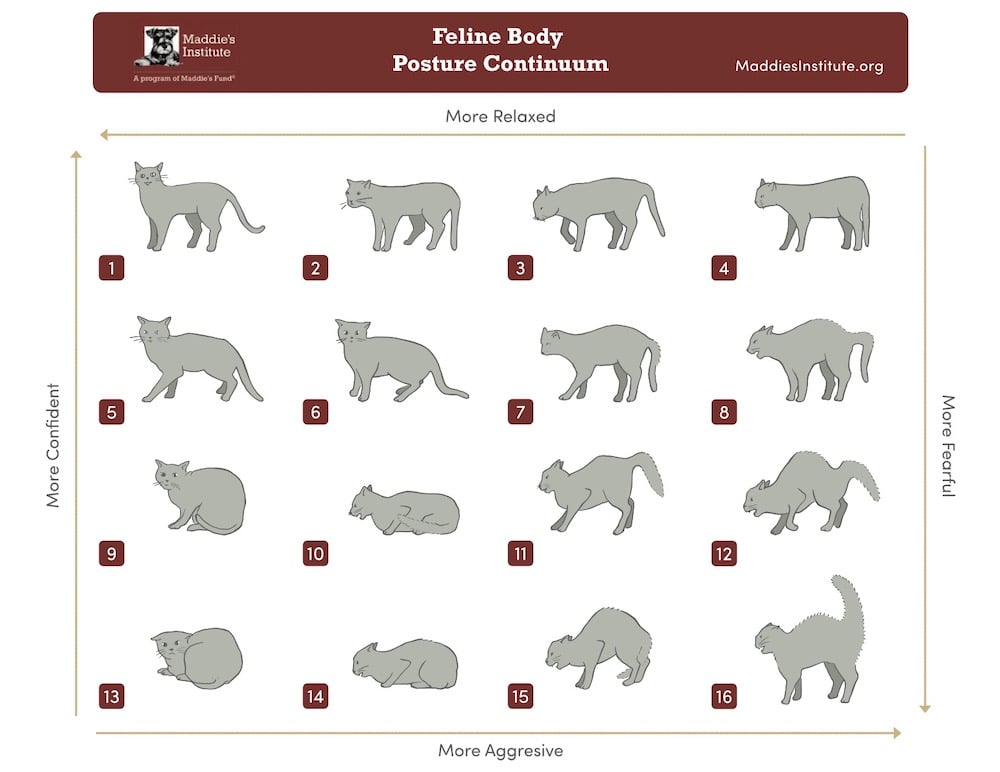
Back Arched and Fur Erect ('Halloween Cat')
This is associated with a defensive threat. As this stance progresses, the cat takes on a typical "Halloween cat" appearance. The cat leans back, presenting the side of their body to the perceived aggressor rather than a straightforward view. In addition, the ears are usually flattened, the corners of the mouth are pulled back to bare teeth, the whiskers are drawn against the side of their head, and their nose is wrinkled. All of these gestures make the cat appear larger and more threatening and are meant to cause the potential enemy to look elsewhere for a less daunting victim.

Body Position Backward
When cats have all of their weight backward, it indicates they are very scared and in defensive mode. They’re trying to look and sound as big and intimidating as possible, in hopes of driving off whatever they’re afraid of. They’re also moving away from the target, looking for an escape route, while still facing the target, sometimes with a sideways glance, and prepared to defend themselves if needed. Hissing and growling are common in this state.
Moving Away – Distance Increasing
Distance-increasing body movements are usually silent patterns of behavior, like walking, shifting, or looking away from an unwelcomed stimulus while scoping out an escape route. It is an avoidance behavior that indicates the cat prefers to avert contact with the stimulus, whether it be a person, another animal, object, odor, or location.
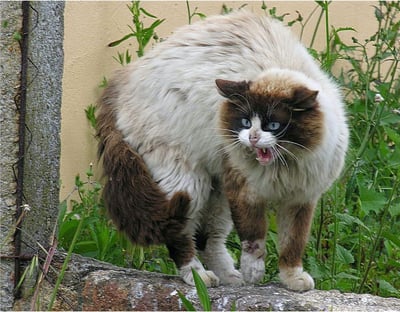
Piloerection ('Raised Hackles' or Hair Standing on End)
Piloerection, often called "raised hackles," is a nervous reflex that causes tiny muscles in the skin at the base of each hair to involuntarily contract, resulting in the hair being lifted away from the skin. It is usually triggered by cold, fright, or arousal, including aggression.
Running
Running can be in response to play or fear, be used in pursuit of prey or enemies, or just a means of getting to a different location quickly. Whether done in play, hunting, or pursuing an enemy, running takes on the form of a chase. When invoked by fear, it provides a quick getaway from the source of the fright. Check out this video to see cats running.
Swatting
Swatting is when cats use their front paws to strike or slap at an object with varying degrees of force and speed. The cat is sending a message to back off, but not necessarily wanting to cause physical injury. So, the claws are usually not exposed (though a long nail can cause an unintentional scratch).
The target of the swatting may be making the cat nervous or feel unsafe, or the target could just be pushing the swatter’s boundaries and patience. Swats can be fairly slow and gentle in less intense situations or quite fast and furious if the cat really feels they need to get the target to move away. Here's a video showing cat swatting:
Scratching
Scratching means that the claws are exposed as a cat swats or bunny kicks a target. This is an aggressive response intended to cause physical injury — usually as a means of self-protection, trying to drive away the target.
Claws also come out when cats hunt prey. This means there’s some potential for scratches when cats play because play is essentially a hunting practice.
Your cat may scratch you when they’re going after your feet under the covers or pouncing on your hand as you grab a toy. This doesn’t mean they’re trying to hurt you. Their claws can’t be completely retracted, so there’s always a bit of claw exposed that can grab skin or scratch during even basic movements. Here's a video explaining cat scratching:
Tail Lowered – Base and Tip Curved
When the tail is lowered and the base and tip are curved, forming a "hook," it is a sign of defensive aggression. The cat may also bristle the hair on the tail, arch their back, and do a bit of a crab walk.
However, with all things cat-related, context is important. Some cats, especially highly playful kittens, will do this hooked tail, arched back, and crab walk during play sessions when they really get into it. Cats do this often when they’re surprised during play, like when their playmate jumps out from behind a door. While it’s not a sign of true defensive aggression in that case (they're practicing the “look”), it can mean a cat is pretty riled up and possibly overstimulated. You might want to give them a moment to calm down before engaging.
See this in action in this video:
Tail Twitching or Thrashing
Tail movements are a big clue into how your cat is feeling or responding to a situation. But, again, context matters. An agitated, hard-tail twitch can mean excitement during play or stress during a tense interaction. As always, look at other body language clues and the environment to help determine what your cat is communicating.
Tail twitching can range from soft, slow, and gentle to jerky and fast, to full thrashing and smacking the floor. While every cat is different, it’s fairly safe to assume that the more agitated, jerky, or big the twitch is, the more intense the cat’s feelings.
For example, a slow swish might be used when a cat is relaxing and another cat comes over and bothers them a bit. A very jerky, quick twitch might be used when a cat is getting stressed or really nervous. You’ll also see it when they get overstimulated or are about to pounce on something.
A hard, thrashing movement is more common during more intense interactions that have the potential to turn serious and aggressive.
Here's a video showing tail twitching:
Tail Vertical and Curved
If the tail extends further over the back in a U-shaped, concave position, it is associated with defensive aggression, avoidance, and distance-increasing measures.
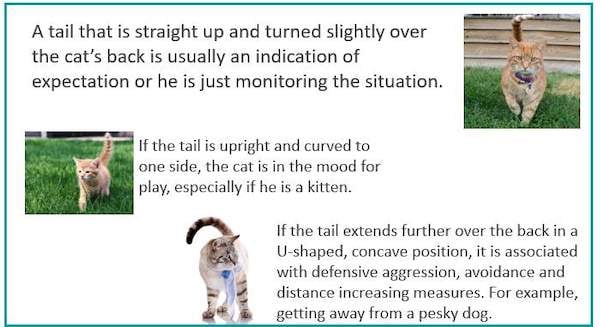

Tail Vertical, Fur Erect
A tail that is straight up with puffed-out hairs (piloerection) of the tail is an indicator of the defensive behavior of a fearful cat or the offensive behavior of a severely agitated cat. It is done as a response to make the cat look bigger in an effort to ward off any threats.
Cat Facial Expressions and Actions that Can Indicate Aggression
Facial expressions are thought to convey more subtle and rapid communications than those of the body. Consequently, they may more accurately represent rapid changes in context or motivational state. When a cat conveys a message, the face and the head give much of the information, which is typically supported by the rest of the body.
Similar to the Feline Body Posture Continuum, take a moment to study the Feline Facial Expression Continuum below to see how the ears, eyes, head carriage, mouth, and whiskers demonstrate the facial expressions of a cat from confident and relaxed to highly aroused, fearful, aggressive, and many states in between. Pay particular attention to the direction of the ears, pupil size, how far the head is from the body, and whisker placement.

Biting
Cats bite for many reasons and with varying degrees of pressure. While a bite can be quite serious and cause injury, they can also be given as gentle warnings. The harder the bite, the more intense your cat is probably feeling.
Cats bite during hunting, of course. This bite is meant to do damage and ultimately contribute to the death of their prey. So, these bites are harder and more targeted.
If they bite during hunting, that means they’ll also bite (though hopefully much more softly) when playing. That’s because play is practice for hunting. In these cases, they’re not trying to inflict harm, but that doesn’t mean it won’t happen. Cats can easily get overstimulated or underestimate the power of their bite, especially with kids and older adults who may have thinner skin, or if you’re playing too rough using your hands or feet.
Cats will also use biting as a way of saying, “Hey, you need to respect me.” We think this is often the intent when one cat bites the neck of another (outside of mating). You’ll see older cats do this with younger cats as a way of setting boundaries.
They also use biting to stop unwanted interactions. You’ve probably had experiences with your cat biting you, sometimes gently and other times with more force, when you’ve petted areas they prefer not to be petted. A cat might do a light bite to another cat who’s annoying them.
These last two examples (respect and stopping unwanted interactions) are inhibited bites. This just means the bite is not intended to do damage. The cat is intentionally controlling how much force they use as opposed to letting instinct take over and doing what needs to be done to protect themselves or take down their prey.
That leads us to the protective bite. Teeth are one of a cat’s most powerful weapons, and they certainly use them if they feel they’re in danger. While they’d prefer to scare a potential target off rather than engage (because they don’t want to put themselves in physical danger), they’ll use teeth and claws to defend themselves when needed.
Learn more about cat biting intentions in this video from Maddie's Fund:
Ears Flattened ('Airplane Ears')
This ear position is often referred to as "airplane ears" because the ears look a bit like airplane wings jutting from each side of the cat's head. This happens as a cat feels threatened or uneasy, signaling fear or defensiveness. The cat does this as a way of protecting the ears — keeping them out of range of things like claws and teeth — in preparation for what might come next. Consider "airplane ears" to be early warnings to back off and stop whatever has prompted the cat to feel threatened.
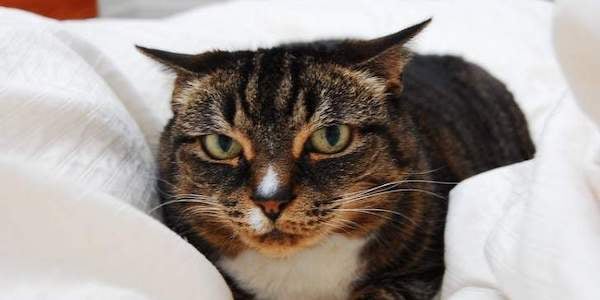
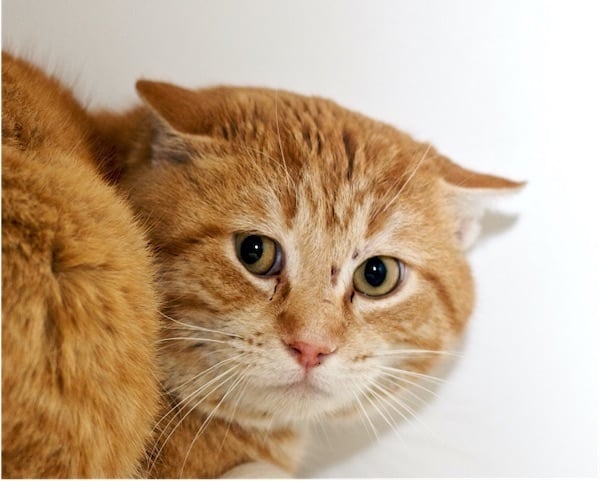
Ears Raised or Backward
When a cat moves their ears from a front-facing forward position to a backward one, it is an offensively aggressive gesture. Ears pricked up and turned backward indicate a warning that an attack is being contemplated. The less backward positioning of the ears, along with other expressions like a set neck and shoulders, slightly lowered head, and clamping of the mouth, indicate a more confident and offensively aggressive cat.
Consider the backward positioning of the ears to be early ear warnings to back off and stop whatever has prompted the cat to respond in this way.
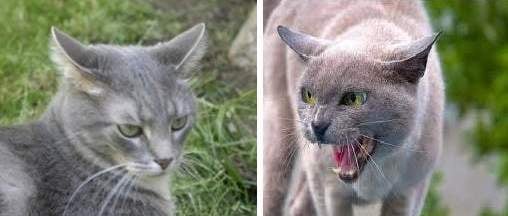
Ears Twitching
Twitching ears can happen when a cat is stressed or agitated. In fact, the ears can be as telling as the tail when trying to figure out how your cat is feeling. Context matters here as well.
If something is irritating or moving the small hairs in and around your cat’s ears, they may twitch. You’ll notice this if you very gently touch those hairs or blow lightly on them. It’s the same way you’d scratch your ear if you had a tickle or can feel the hair on your head move in the breeze.
But cats will also twitch their ears as a stress response. Just like the tail, it’s usually safe to assume that the more intense the twitching the more stressed or agitated the cat is. If things continue to progress, you’ll likely see some of the other body language cues we’ve discussed, like the fur standing on end, airplane ears, and arching back. Things need to de-escalate so your cat can calm down and reset.
Twitching may also happen during intense play if they’re really trying to replicate that defensive posture.
If your cat suddenly has ear twitching with no other signs of stress, or they’re rubbing and pawing at their ears, there could be something medical going on, like an ear infection. It’s time to talk with your veterinarian. You might even take video of the behavior to show your vet.
This video explores examples of cat ear twitching:
Head Lowered
A lowered head carriage can mean different things. Cats who feel fearful typically will lower their head as a sign of withdrawal and an attempt to avoid interaction. It can also be used by a cat on the offensive. This is usually coupled with slowly walking directly toward the subject of their angst with their eyes fixed on the target.
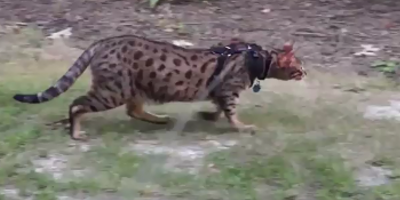
Head Stretched Forward
A head stretched forward is ready for contact. Other gestures will indicate whether the encounter is intended to be aggressive, like straight legs and elevated hindquarters, or friendly, like a straight back and relaxed rear legs.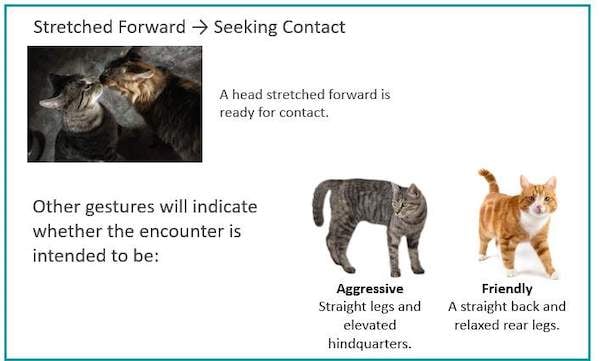
Mouth Open – Teeth Exposed
When a cat’s mouth is open with teeth bared, the lips pull back, causing the nose to wrinkle. This is commonly accompanied by hissing and is an indication of intimidation and defensive aggression.
Pupils Constricted (Small)
In bright light, pupils contract to slits (constrict). However, they also constrict in response to irritation, as well as feelings of tension and aggression.

Staring
Are you familiar with the sequence cats go through when they hunt? First, they stare. Then they move on to stalking, chasing, pouncing, and the kill bite. It’s that first step – staring – that can signal to prey that they’re about to get attacked. It’s the same when cats stare at each other (or we stare at them). They see it as a sign of danger and potential attack.
If they do it when hunting, they’ll often do it when playing. You’ll see cats stare before a big pounce. They may get down low and do the bootie wiggle while they’re staring. This is true whether it’s a toy, another cat, or your legs as you walk down the hall. Staring often starts the process.
A cat trying to intimidate or scare off another cat may stare. Sometimes it’s subtle. Other times it’s very intense. In fact, it’s common for people to think one of their cats is bullying another, only to realize later that the one they thought was being bullied was actually doing very subtle staring that caused the other cat to get nervous and defensive.
There are differing opinions on the idea of nervous cats avoiding a stare and cats staring to establish a pecking order. A scared cat may be afraid to look away because they don’t want to leave themselves open to a sneak attack. Or they may stare in hopes of getting the aggressive cat to back down. On the other hand, they may avoid eye contact due to their fear. Different cats in different situations will use staring in a variety of ways.
Check out these examples of staring body language in this video:
Whiskers Pulled Back
When cats pull their whiskers back against the cheeks and bunch them together, it is usually an indication of fear. When in a fight or just eating, this is a way of getting the whiskers out of the way and protecting them.
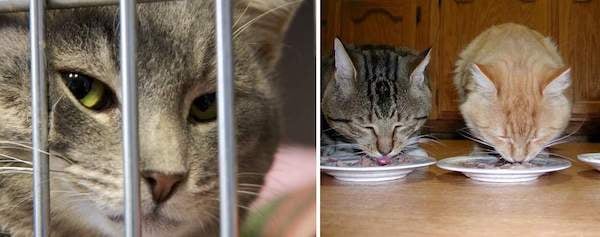
Cat Vocalizations that Indicate Aggression
Growling
A growl is a clear sign that you need to pay attention. This is a cat having very intense feelings.
If a cat feels they’re in danger and really wants the target to back off, they may start with growling before moving on to louder, scarier vocalizations or physical defensive aggression. The growl often gets louder as the cat gets more upset. In this situation, you want to try and remove the trigger or target quickly but may want to avoid interacting with the growling cat directly until they calm down.
Cats will also growl during hunting. It’s usually when they’ve caught their prey. Their senses are all activated and tingling, they’ve just defeated their “enemy,” and they’re a bit worked up.
These are the same reasons your cat may growl a little during play. Again, it’s usually when they’ve caught their “prey” (most likely the lure at the end of a wand toy) and carried it off to revel in their victory. Because they’re feeling those intense sensations, they could be quick to play aggressively. So, it's best to give them a little space with their “prey” or use another toy to get them back into the hunt and to burn off that energy.
As always, look at context and other body language cues to help understand whether your cat is having a fear response or an intense hunting response.
In this video, listen to an example of a cat growl:
Hissing
Hissing is usually another sign of intense feelings, most often fear. The hiss sounds like a very forceful, fast passing of air through the throat. The mouth is open and teeth exposed, the upper lip is drawn back wrinkling the face, and the tongue is arched – making for an intimidating facial expression.
Cats usually deploy their hiss as a warning to potential threats that they’re not interested in having an interaction and that threat needs to back off.
Though not as common, some cats use hissing less impactfully. Much like a gentle bite, they may hiss as a way of ending even a low-intensity interaction that’s unwanted. This is something often seen with cats whose boundaries are not respected. They’ve learned that the only way to get the person or other animal to move away or stop doing something is to hiss.
They’ll also use hissing to set boundaries. When a high-energy cat is getting to know a more mellow cat, you may get some hissing from the mellow cat as their way of letting the other know when they’re too close or too much. Ideally, the other cat learns how to act around the hissing cat, so hissing is no longer needed. The boundary has been set.
Listen to this example of a cat hiss:
Howling or Yowling
This is always an upsetting sound. It’s a long, low, unsettling sound. Most of the time, this is an escalation from hissing and growling. Now things are getting really serious. This cat in the video is very scared and trying to get their target to leave before a fight breaks out. You may hear cats doing this from opposite sides of the street, before they even get close enough to fight, in hopes of ending things before fighting is necessary.
There’s not always a target. Just that sense of fear can cause howling or yowling. You may hear this from cats in a shelter or at the vet, even when in a kennel with no one around.
Cats may also howl in this way when they’re feeling pain. Therefore, it can be an indication of a health problem. If no environmental stressor can be identified, it is recommended that the cat be seen by a veterinarian.
Snarling
A much heightened vocalization than the growl, the snarl is coupled with a louder sound with a higher pitch, and often a display of the teeth. Snarling is on the continuum of escalating aggression and is usually preceded by the first vocal warning sign, growling. It means the claws have been drawn out — or will be shortly. As with growling, it is best to leave this cat alone!
You can see, from all these vocalization examples, that cats use a lot of tactics to try to end interactions before they have to get into a physical altercation. This is yet another escalation in trying to get the target to back off. By this point, a fight is on the horizon. These cats need to get away from each other quickly to avoid one.
Watch these two cats and listen for the snarling:
Spitting
Spitting is a short, popping sound made by curling up the tongue and forcing a burst of air out. It is a defensive sound that is usually made when the cat is surprised. Spitting often precedes or follows a hiss. The cat expels their breath so hard that, if you were close enough, you could feel a jet of air. The moisture the cat releases with this gusty breath is why this vocalization is called spitting.
Can you hear the spitting of the cat in this video in between the two hisses?
Well, you have gotten a great start on your road trip to having a better understanding of feline communication! Contrary to their reputations for being mysterious creatures, cats are very communicative. We just have to know what to watch and listen for. Understanding their language takes some practice.
If you are interested in learning more, take the Maddie’s University Feline Communication: How to Speak Cat course. It’s free and you will learn how to, well, “Speak Cat”!


